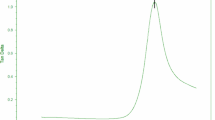Abstract
In the manufacturing of polymeric microfluidic devices, micro-molds play a key role because they determine not only the manufacturing cost but also the quality of the molded parts. Recently, a high-quality aluminum alloy 6061 (AA6061) mold with fine features less than its grain size has been fabricated economically by a hot embossing technique. However, temperature cycling during hot embossing process in mold manufacturing reduces significantly the original tensile strength and hardness of the AA6061-T6 alloy substrate, which is not desirable. In this study, a tempering process is carried out to recover the tensile strength and hardness of the embossed mold. To evaluate the changes of these properties, surface roughness, tensile strength, and hardness values were measured in each stage: (1) before hot embossing, (2) after hot embossing, and (3) tempering to T4 and tempering to T6. The results obtained demonstrate that the original strengths and hardness can be fully recovered by a post-tempering process after hot embossing, but with an increase in surface roughness. Moreover, accelerated testing was carried out to evaluate the changes in hardness and roughness of AA6061-T4 and T6 molds under the typical hot embossing temperature cycles of manufacturing polymeric devices. The results obtained indicate that these temperature cycles have only a minor effect on the roughness of both T4 and T6 molds and will increase the hardness of T4 molds to T6 temper, and have negligible effect on the hardness of a T6 temper mold.
Similar content being viewed by others
References
Madou MJ, Lee LJ, Daunert S, Lai S, Shih CH (2001) Design and fabrication of CD-like microfluidic platforms for diagnostic: microfluidic functions. Biomed Microdevices 3(3):245–254
Whitesides GM, Stroock AD (2001) Flexible methods for microfluidics. Phys Today 54(6):42
Becker H, Locascio LE (2002) Polymer microfluidic devices. Talanta 56(2):267–287
Pham PH, Dao DV, Amaya S, Kitada R, Sugiyama S (2007) Fabrication and characterization of smooth Si mold for hot embossing process. IEEJ Trans Sens Micromach 127(3):187–191+115
Hupert ML, Guy WJ, Llopis SD, Shadpour H, Rani S, Nikitopoulos DE, Soper SA (2007) Evaluation of micromilled metal mold masters for the replication of microchip electrophoresis devices. Microfluid and Nanofluid 3(1):1–11
Zhao DS, Roy B, McCormick MT, Kuhr WG, Brazill SA (2003) Rapid fabrication of a poly(dimethylsiloxane) microfluidic capillary gel electrophoresis system utilizing high precision machining. Lab Chip Miniaturisation Chem Biol 3(2):93–99
Cao DM, Jiang J, Meng WJ, Jiang JC, Wang W (2007) Fabrication of high-aspect-ratio microscale Ta mold inserts with micro electrical discharge machining. Microsyst Technol 13(5–6):503–510
Cao DM, Jiang J, Yang R, Meng WJ (2006) Fabrication of high-aspect-ratio microscale mold inserts by parallel μEDM. Microsyst Technol 12(9):839–845
Pfleging W, Hanemann T, Bernauer W, Torge M (2002) Laser micromaching of polymeric mold inserts for rapid prototyping of PMMA-devices via photomolding. In: Sugioka K, Gower MC, Haglund JRF, Pique A, et al. (eds) Photon Processing in Microelectronics and Photonics. Proceedings of SPIE—The International Society for Optical Engineering, pp 318–329
Pham DT, Dimov SS, Ji C, Petkov JV, Dobrev T (2004) Laser milling as a 'rapid' micromanufacturing process. Proc Inst Mech Eng Part B-J Eng Manuf 218(1):1–7
Pun PS, Knopf GK, Ostojic M, Nikumb S (2007) Rapid fabrication of micromolds for polymeric microfluidic devices. In: 2007 Canadian Conference on Electrical and Computer Engineering, CCECD. Institute of Electrical and Electronics Engineers, pp 8–11
Forster R, Schoth A, Menz W (2005) Micro-ECM for production of microsystems with a high aspect ratio. Microsyst Technol 11(4–5):246–249
Becker EW, Ehrfeld W, Hagmann P, Maner A, Münchmeyer D (1986) Fabrication of microstructures with high aspect ratios and great structural heights by synchrotron radiation lithography, galvanoforming, and plastic moulding (LIGA process). Microelectron Eng 4(1):35–56
Bohm J, Schubert A, Otto T, Burkhardt T (2001) Micro-metalforming with silicon dies. Microsyst Technol 7(4):191–195
Uriarte L, Herrero A, Ivanov A, Oosterling H, Staemmler L, Tang PT, Allen D (2006) Comparison between microfabrication technologies for metal tooling. Proc Inst Mech Eng C 220(11):1665–1676
Heckele M, Schomburg WK (2004) Review on micro molding of thermoplastic polymers. J Micromech Microeng 14(3):R1–R14
Cho MS, Lim HW, Lee CS, Cho BK, Park JG (2008) Fabrication of stainless steel mold using electrochemical fabrication method for microfluidic biochip. Jpn J Appl Phys 47(6 PART 2):5217–5220
Madou MJ (2002) Fundamentals of microfabrication: the science of minituarization, 2nd edn. CRC, Boca Raton, p 392
Shin HS, Chung DK, Park MS, Kim BH, Chu CN (2010) Electrochemical etching of stainless steel through laser masking. J Micromech Microeng 20(5):055030
Narasimhan J, Papautsky I (2004) Polymer embossing tools for rapid prototyping of plastic microfluidic devices. J Micromech Microeng 14(1):96–103
Belligundu S, Shiakolas PS (2006) Study on two-stage hot embossing microreplication: silicon to polymer to polymer. J Microlitogr Microfabr Microsyst 5(2):021103
Koesdjojo MT, Tennico YH, Rundel JT, Remcho VT (2008) Two-stage polymer embossing of co-planar microfluidic features for microfluidic devices. Sens Actuators, B Chem 131(2):692–697
Henann D, Anand L (2008) A constitutive theory for the mechanical response of amorphous metals at high temperatures spanning the glass transition temperature: application to microscale thermoplastic forming. Acta Mater 56(13):3290–3305
Tran NK, Lam YC, Yue CY, Tan MJ (2010) Manufacturing of an aluminum alloy mold for micro-hot embossing of polymeric micro-devices. J Micromech Microeng 20(5):055020
Lam YC, Tran NK, Yue CY, Tan MJ (2011) New deformation phenomenon for micro-formability of polycrystalline materials. Mater Sci Eng, A 528(3):1906–1909
SAE AMS 2770H (2006) Heat treatment of wrought aluminum alloy parts. SAE International, Warrendale
Smith C (1984) Engineer to win. MBI, Osceola, p 70
Martino R (1989) Modern plastics encyclopedia. McGraw Hill, New York
Author information
Authors and Affiliations
Corresponding author
Rights and permissions
About this article
Cite this article
Tran, N.K., Lam, Y.C., Yue, C.Y. et al. Evaluation of roughness, hardness, and strength of AA 6061 molds for manufacturing polymeric microdevices. Int J Adv Manuf Technol 60, 1215–1221 (2012). https://doi.org/10.1007/s00170-011-3673-z
Received:
Accepted:
Published:
Issue Date:
DOI: https://doi.org/10.1007/s00170-011-3673-z



